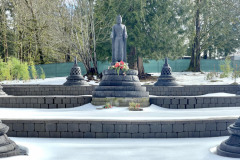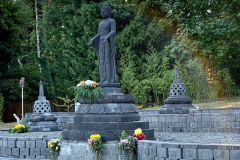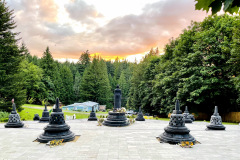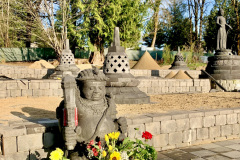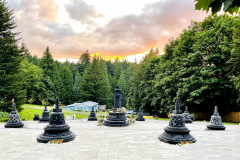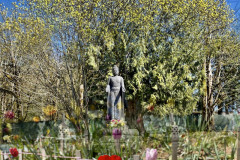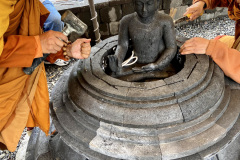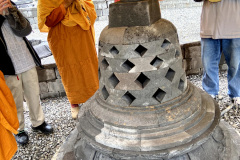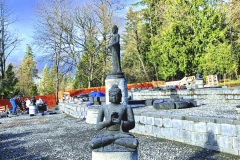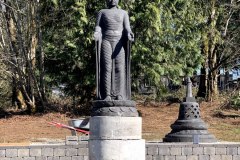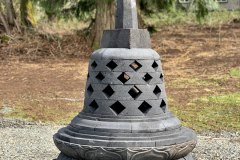*Photo gallery at the end of article.
It is with extreme gratitude that Oregon Ariyamagga Okasati Refuge (OAOR) has opened the Ariyamagga Pagoda, a unique homage to the Borobudur Temple in Indonesia. Ariyamagga means the eightfold path. How wonderful and fortunate OAOR is to host such a beautiful representation of the Buddhist path.
What makes this pagoda unique in the world is the way the eightfold path is represented by varied Buddha postures inside each of the eight pagodas, and the tall standing Buddha in the center. The pagoda is a landmark for OAOR and represents the Triple Gem: the Buddha, Dhamma, and Sangha.
Each Buddha posture offers a different story, reflecting each of the eight directions. The Buddha opens the three worlds, enabling one to see the results of unwholesome and wholesome actions, speech, or thoughts as causes for suffering. The pagoda is a seed for change.
The pagoda garden is approximately 60 feet in diameter, and the standing Buddha is over six feet tall. In addition to the pagodas and standing Buddha, the garden includes four protectors, and a large standing vessel for ceremonial incense offerings.
The Ariyamagga Pagoda came together unexpectedly, since there were no plans for something like this at OAOR. Synchronicity and dhamma brought it into reality bit by bit.
In early 2019, more than 1,000 Indonesian people offered a replica of part of the Borobudur Temple, the largest Buddhist monument in the world, to OAOR as a way to honor their teacher Luang Por Jamnian. The Borobudur Temple was built of stone, between AD 780 and 840, as a pilgrimage spot and place to pay homage to the Buddha. The generous offering of pagodas to OAOR unites three cultures — Thai, Indonesian, and Western (United States) — and it is dedicated to the benefit of all beings.
As the pagoda project first started evolving prior to the pandemic, Indonesian engineers and donors traveled to OAOR to visit the site. The engineers developed a design, and a master Indonesian lava stone carver started work using Indonesian stone. The pagodas are made of pieces that fit together like a puzzle, needing no adhesive.
Meanwhile: Pagoda plans were adjusted and finalized by Ajahn Ngam in Thailand. He is the most senior monk under Luang Por Jamnian, and a master teacher for OAOR. Work progressed in Indonesia, and supporters of OAOR began preparing the Oregon site. A LOT of labor and gravel later, and the site was ready to receive the shipment.
Once the carvings were completed, they were crated for shipment to the U.S. And what a shipment it was! Many crates weighed more than 2,000 pounds each, and the standing Buddha weighed more than 850 pounds.
Installation began early in 2020 as weather allowed. However, the project has taken more than a year to complete, partly because the pandemic reduced fund raising and volunteers. The last steps were installing the final pavers for the upper tier, which were the last stones shipped from Indonesia.
All of this was made possible by OAOR’s purchase of just under five acres of property in Sandy, Oregon in 2017. The site includes an extremely modest residence for monastics at the lower end of the property, and the pagodas are on the hillside behind the residence.
For additional information about OAOR or visiting, please see the About and Contact pages on this website.
